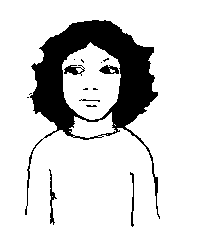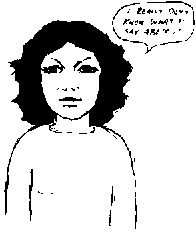
Analysis: She begins with the external visual stimulus from the written report (Ve ) which she has probably read in detail sometime earlier.
Predicate: "look over"
Accessing cue: Eyes scan external object.

Analysis:The visual stimulus accesses internal kinesthetic sensations (Ki) about what was printed.
Predicate: "I get the feeling"
Accessing cue: Deep breath, eyes move down and right.

Analysis:These feelings then initiate an internal auditory digital response (Aid).
Predicate: "ask myself”
Accessing cue: Eyes down and left, hand strokes chin.

Analysis:She then constructs a series of internal visual images in response to the internal verbalization (Vc1 , Vc2, … Vcn).
Predicate: "clear understanding"
Accessing cue: Slight shifts of the eyes while in up and right position.

Analysis:The constructed images access internal feelings (Ki).
Predicate: -
Accessing cue: Eyes down and right.

Analysis:Were the decision to be made, or still in progress, the administrative director would be able to make some verbalization (Ad) in response to the feelings to either exit or continue the decision process. Her comment here, however, indicates the absence of experience within that representational system. (Lack of information is information.)
Predicate: "don't know what to say about it."
Accessing cue: -
Assume this administrative director is talking to you. Perhaps you have submitted the report she is reviewing and have some concern about the outcome of the decision. Perhaps you are a consultant assisting the person in making this important decision. In any case, you wish to access resources to help this administrator deal with her indecisiveness. In our way of thinking, arguing with or confronting the person over the content of the proposal will typically be of little value in helping her get the decision made. It is the way the individual processes the content (her strategy) that is important in cases like this. She has already given you all of the information you need to unpack the strategy that is leading to the indecision:
We could notate this strategy in the following way:

You will notice that we have bracketed the series of constructed visual images, one beneath the other, to indicate that they occurred in the same step. We have put the (?) in front of the A^ step to indicate that even though it is the appropriate next step in the strategy, the activity within it has not reached a sufficient magnitude for the strategy to continue.
You could also punctuate the strategy into the following functional steps.
1) The external visual experience of the written material anchors, synesthetically, the kinesthetic representation of an incongruence the administrator has derived from previous testing of the material in the report.
2) The content of the feelings were such that they initiated an operation involving internal dialogue (asking herself a question) and generating images on the basis of the verbalization.
3) The constructed images were then tested against one another or against remembered images (this isn't specified directly by the administrator's behavior, nor is it particularly important for the analysis of the strategy), and an incongruence again appears, in the form of feelings, that blocks the strategy from existing.
4) Some constraint, however, prevents the individual from operating again — the first step in her operation procedure, auditory digital activity, doesn't have enough signal strength to initiate any new images ("I don't know what to say about it."') The constraints could be caused by the feelings of incongruence overriding the administrator's internal dialogue, or by interference from other representational systems bringing up time constraints, or by the need to gather more information before a successful operation may be made, or even because the present operational strategy could be ineffectual.
From the short statement made by the administrator we can determine the essential elements of her decision making strategy. These can be represented in their most elegant form as:

This shows that she typically starts with auditory digital activity, derives internal visual images from that activity, tests the images, the results of which are represented kinesthetically, and on the basis of these feelings will either exit or cycle back through the strategy. We will return to this example after a brief but important excursion into notational punctuation.
3.241 Expanding 4–Tuple Notation — Part II
At this juncture we would like to add a final set of modifiers to the behavioral calculus that we have presented so far. These modifiers have to do with the relationships between the representational components of the strategy. These modifiers distinguish whether a step in a strategy is a congruent response, polarity response, or a meta response to the step before it.
a. We will define a congruent response as essentially a continuation of the representation before it but in a different modality. A "modality" difference, here, will be constituted by a change in any of the 4–tuple modifiers we have presented so far. A switch from a visual external to a visual internal representation would constitute a modality change. So would a switch from constructed auditory experience to remembered auditory experience, or from a digital auditory representation to a tonal representation.
For example, if an individual is deciding whether or not to take a swim, he may go through a strategy in which he looks up and to the left and sees how it looked through his own eyes the last time he was swimming, in his mind's eye. A congruent response to this image in the kinesthetic system would be experiencing the body sensations of physically being in the water. A congruent response, in turn, to these body sensations in the auditory tonal representational modality would be hearing the sounds of the water lapping the edges of the pool and covering his ears as he ducks below the water surface.
We will notate a congruent response by simply using an arrow " '", to point from the initiating step to the one that is a congruent response to it. In the case of our example: